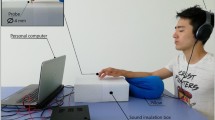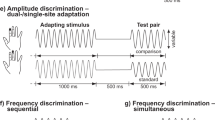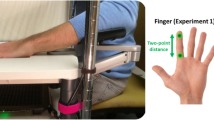Abstract
For the wide range of vibration frequencies, the human capacity for vibrotactile frequency discrimination has been reported constant. However, vibrotactile detection depend on two different receptors, one is Meissner corpuscle for low frequencies and the other is Pacinian corpuscle for high frequencies. To examine the impact of input pathway on frequency discrimination task, discrimination capacity has been compared directly by using supra-threshold and near-threshold stimuli since near-threshold stimuli mainly activate one input pathway. Each standard frequencies 15, 30, 60, 120, 240 and 480 Hz at amplitude 6dB and 16 dB detection threshold, was paired with a series of comparison frequencies, and discrimination capacity was quantified by the discriminable frequency increment (Δf) and the Weber Fraction (Δf/f). The result revealed constant and good discrimination capacities for strong stimulus conditions but discrete and bad capacities for weak stimulus conditions. Near-threshold stimuli produced a marked impairment in vibrotactile discrimination at the high standard frequencies around 240 Hz, probably detected by Pacinian corpuscle, but relatively little effect at lower frequencies, mainly detected by Meissner corpuscle.
Access this chapter
Tax calculation will be finalised at checkout
Purchases are for personal use only
Preview
Unable to display preview. Download preview PDF.
Similar content being viewed by others
References
Gescheider, A., Bolanowski, S.J., Hardick, K.R.: The frequency selectivity of information-processing channels in the tactile sensory system. Somatosens Mot. Res. 18(3), 191–201 (2001)
Talbot, W., Darian-Smith, I., Kornhuber, H., Mountcastle, V.B.: The sense of flutter-vibration: Comparison of the human capacity with response patterns of mechanoreceptive afferents from the monkey hand1. J. Neurophys. 31(2), 301–334 (1968)
Goff, G.: Differential discrimination of frequency of cutaneous mechanical vibration. J. Exp. Psychol. 74, 294–299 (1967)
Mahns, D., Perkins, N., Sahai, V., Robinson, L., Rowe, M.: Vibrotactile frequency discrimination in human hairy skin. J. Neurophys. 95(3), 1442–1450 (2006)
LaMotte, R., Mountcastle, V.: Capacities of humans and monkeys to discriminate vibratory stimuli of different frequency and amplitude: a correlation between neural events and psychological measurements. J. Neurophys. 38(3), 539–559 (1975)
Mountcastle, V., Talbot, W., Sakata, H., Hyvarinen, J.: Cortical neuronal mechanisms in flutter-vibration studied in unanesthetized monkeys: Neuronal periodicity and frequency discrimination. Journal of Neurophysiology 32(3), 452–484 (1969)
Author information
Authors and Affiliations
Editor information
Editors and Affiliations
Rights and permissions
Copyright information
© 2012 Springer-Verlag Berlin Heidelberg
About this paper
Cite this paper
Kuroki, S., Watanabe, J., Nishida, S. (2012). Dissociation of Vibrotactile Frequency Discrimination Performances for Supra-Threshold and Near-Threshold Vibrations. In: Isokoski, P., Springare, J. (eds) Haptics: Perception, Devices, Mobility, and Communication. EuroHaptics 2012. Lecture Notes in Computer Science, vol 7283. Springer, Berlin, Heidelberg. https://doi.org/10.1007/978-3-642-31404-9_14
Download citation
DOI: https://doi.org/10.1007/978-3-642-31404-9_14
Publisher Name: Springer, Berlin, Heidelberg
Print ISBN: 978-3-642-31403-2
Online ISBN: 978-3-642-31404-9
eBook Packages: Computer ScienceComputer Science (R0)




